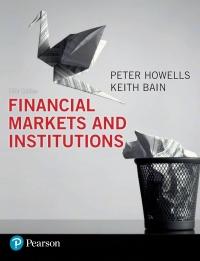Question
Hi. Choose the best answer. State your explanation. 11) Bonus plans should be tied to variable cost income, which is less subject to manipulation because
Hi.
Choose the best answer. State your explanation.
11) Bonus plans should be tied to variable cost income, which is less subject to manipulation because is not affected by inventory level changes, rather than the conventional:
A) Tax-based net income.
B) Marginal cost income.
C) Full cost income.
D) Operating income.
12) The balanced scorecard critical success factors (CSFs) provide strong motivation in bonus compensation plans if noncontrollable factors are:
A) Emphasized.
B) Separated.
C) Recognized.
D) Excluded.
E) Controlled.
13) If fairness only is considered, if a unit manager's unit is doing well, the unit manager prefers:
A) Not to be evaluated.
B) A subjective measure.
C) An informal evaluation.
D) A firm-wide pool over a unit-based pool.
E) A unit-based pool over a firm-wide pool.
14) Generally, the current and deferred types of bonus payment options currently in use tend to focus the manager's attention on short-term performance measures, most commonly:
A) Division profit.
B) After tax corporate profit.
C) Cash flow.
D) Growth in firm value.
E) Stock price.
15) The stock option form of bonus payments to managers usually:
A) Motivates well even in extended market downturns.
B) Can lose some motivation because of the delay in reward.
C) Focuses on the short-term.
D) Is not consistent with shareholder interests.
E) Has less risk than other types of bonus payment plans.
16) The ideal compensation plan would make all company contributions to the plan immediately tax-deductible and all tax consequences for managers:
A) Insignificant.
B) Deferred or avoidable.
C) Limited, but current.
D) Limited, but pre-paid.
17) In management compensation, the use of the balanced scorecard achieves:
A) Fairness.
B) Alignment of manager's incentives and the organization's strategy.
C) The desired ethical environment.
D) Revenue generation and cost control.
E) A specific non-financial measurement.
18) The balanced scorecard evaluation of the firm is an especially strong financial tool because of its:
A) Use of qualitative measures.
B) Use of quantitative measures.
C) Simplicity in use.
D) Ability to predict change.
E) Use of multiple critical success factors (CSFs).
19) The receivables turnover ratio is a measure of:
A) Asset value.
B) Leverage.
C) Sales performance.
D) Profitability.
E) Liquidity.
20) Market value of equity is an objective measure which clearly shows what:
A) The firm's financial statements show the firm's value to be.
B) Investors think is the firm's value.
C) Stock analysts calculate as the firm's value.
D) Is the sales value of the firm.
E) Is the liquidation value of the firm.
-ca
Step by Step Solution
There are 3 Steps involved in it
Step: 1

Get Instant Access to Expert-Tailored Solutions
See step-by-step solutions with expert insights and AI powered tools for academic success
Step: 2

Step: 3

Ace Your Homework with AI
Get the answers you need in no time with our AI-driven, step-by-step assistance
Get Started


